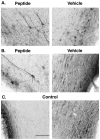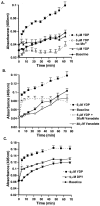Identification of a survival-promoting peptide in medium conditioned by oxidatively stressed cell lines of nervous system origin
- PMID: 9736629
- PMCID: PMC6793258
- DOI: 10.1523/JNEUROSCI.18-18-07047.1998
Identification of a survival-promoting peptide in medium conditioned by oxidatively stressed cell lines of nervous system origin
Abstract
A survival-promoting peptide has been purified from medium conditioned by Y79 human retinoblastoma cells and a mouse hippocampal cell line (HN 33.1) exposed to H2O2. A 30 residue synthetic peptide was made on the basis of N-terminal sequences obtained during purification, and it was found to exhibit gel mobility and staining properties similar to the purified molecules. The peptide maintains cells and their processes in vitro for the HN 33.1 cell line treated with H2O2, and in vivo for cortical neurons after lesions of the cerebral cortex. It has weak homology with a fragment of a putative bacterial antigen and, like that molecule, binds IgG. The peptide also contains a motif reminiscent of a critical sequence in the catalytic region of calcineurin-type phosphatases; surprisingly, like several members of this family, the peptide catalyzes the hydrolysis of para-nitrophenylphosphate in the presence of Mn2+. Application of the peptide to one side of bilateral cerebral cortex lesions centered on area 2 in rats results in an increase in IgG immunoreactivity in the vicinity of the lesions 7 d after surgery. Microglia immunopositive for IgG and ED-1 are, however, dramatically reduced around the lesions in the treated hemisphere. Furthermore, pyramidal neurons that would normally shrink, die, or disintegrate were maintained, as determined by MAP2 immunocytochemistry and Nissl staining. These survival effects were often found in both hemispheres. The results suggest that this peptide operates by diffusion to regulate the immune response and thereby rescue neurons that would usually degenerate after cortical lesions. The phosphatase activity of this molecule also suggests the potential for direct neuron survival-promoting effects.
Figures









Similar articles
-
Calreticulin binding and other biological activities of survival peptide Y-P30 including effects of systemic treatment of rats.Exp Neurol. 2000 Jun;163(2):457-68. doi: 10.1006/exnr.2000.7390. Exp Neurol. 2000. PMID: 10833321
-
Microglial cells protect cerebellar granule neurons from apoptosis: evidence for reciprocal signaling.Glia. 2001 Dec;36(3):271-80. doi: 10.1002/glia.1115. Glia. 2001. PMID: 11746765
-
Neuron-conditioned media differentially affect the survival of activated or unstimulated microglia: evidence for neuronal control on apoptotic elimination of activated microglia.J Neuropathol Exp Neurol. 2003 Apr;62(4):351-62. doi: 10.1093/jnen/62.4.351. J Neuropathol Exp Neurol. 2003. PMID: 12722827
-
Bioactivity of a peptide derived from acetylcholinesterase in hippocampal organotypic cultures.Exp Brain Res. 2004 Apr;155(4):500-8. doi: 10.1007/s00221-003-1757-1. Epub 2003 Dec 18. Exp Brain Res. 2004. PMID: 14685807
-
Kainic acid-activated microglia mediate increased excitability of rat hippocampal neurons in vitro and in vivo: crucial role of interleukin-1beta.Neuroimmunomodulation. 2010;17(1):31-8. doi: 10.1159/000243083. Epub 2009 Oct 5. Neuroimmunomodulation. 2010. PMID: 19816055
Cited by
-
The multiple facets of dermcidin in cell survival and host defense.J Innate Immun. 2012;4(4):349-60. doi: 10.1159/000336844. Epub 2012 Mar 27. J Innate Immun. 2012. PMID: 22455996 Free PMC article. Review.
-
Preclinical Development of Seriniquinones as Selective Dermcidin Modulators for the Treatment of Melanoma.Mar Drugs. 2022 Apr 28;20(5):301. doi: 10.3390/md20050301. Mar Drugs. 2022. PMID: 35621952 Free PMC article. Review.
-
Inhibition of secreted phospholipase A2 by neuron survival and anti-inflammatory peptide CHEC-9.J Neuroinflammation. 2006 Sep 11;3:25. doi: 10.1186/1742-2094-3-25. J Neuroinflammation. 2006. PMID: 16965626 Free PMC article.
-
Dermcidin expression in hepatic cells improves survival without N-glycosylation, but requires asparagine residues.Br J Cancer. 2006 Jun 5;94(11):1663-71. doi: 10.1038/sj.bjc.6603148. Br J Cancer. 2006. PMID: 16685272 Free PMC article.
-
Analysis of Y-P30/Dermcidin expression and properties of the Y-P30 peptide.BMC Res Notes. 2014 Jun 26;7:400. doi: 10.1186/1756-0500-7-400. BMC Res Notes. 2014. PMID: 24969620 Free PMC article.
References
-
- Acharya HR, Dooley CM, Thoreson WB, Ahmad I. cDNA cloning and expression analysis of NeuroD mRNA in human retina. Biochem Biophys Res Commun. 1997;233:459–463. - PubMed
-
- Altschul SF, Boguski MS, Gish W, Wootton JC. Issues in searching molecular sequence databases. Nature Genet. 1994;6:119–129. - PubMed
-
- Beal MF. Aging, energy and oxidative stress in neurodegenerative diseases. Ann Neurol. 1995;38:357–366. - PubMed
-
- Bigot D, Hunt SP. Effect of excitatory amino acids on microtubule-associated proteins in cultured cortical and spinal neurones. Neurosci Lett. 1990;111:275–280. - PubMed
-
- Bigot D, Matus A, Hunt SP. Reorganization of the cytoskeleton in rat neurons following stimulation with excitatory amino acids in vitro. Eur J Neurosci. 1991;3:551–558. - PubMed
Publication types
MeSH terms
Substances
Grants and funding
LinkOut - more resources
Full Text Sources
Other Literature Sources
Molecular Biology Databases
